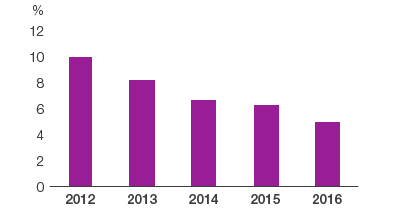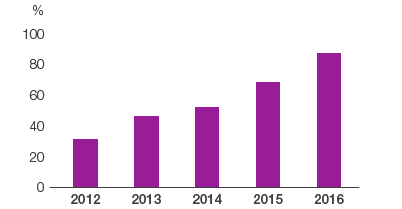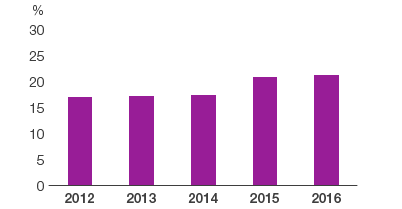Health and safety
Health and safety is fundamental to SCA’s operations. SCA has a zero-accident vision and safety in the workplace is highly prioritized. In addition to promoting health and safety at its sites, SCA checks suppliers’ practices and collaborates with them to improve safety performance.
Health and safety target
Accident Frequency Rate (FR)

The accident frequency rate declined by 27% in 2016. Compared with 2012, the decline was 54%.
SCA has established a health and safety target to reduce the accident frequency rate by 50% in the 2014–2020 period.
We are sad to report one fatality in Mannheim, Germany, reinforcing the need for consistent focus on safety improvements. In addition, one contractor lost his life in connection with elevator maintenance in the office building in Mannheim.
In 2016, the accident frequency rate declined by 27% year-on-year to 4.6 (6.3, 6.7) and 31% compared with the base year of 2014. In particular, statistics improved for the forest products business, which reduced its frequency rate by 29%. The forest products’ business has intensified its occupational safety efforts under its zero-accident program, see chapter Health and Safety.
OHSAS 18001 certification
OHSAS 18001 certified sites

12 main sites were certified under OHSAS during 2016. A main site is defined as a production site wholly owned by SCA with 100 or more employees.
SCA implements the international OHSAS 18001 (Occupational Health and Safety Assessment Series) standard to ensure that uniform processes are deployed across the Group, and that SCA units continuously improve their workplace health and safety. OHSAS specifies requirements for an organization’s occupational health and safety management systems.
SCA has established a target that all wholly-owned and joint-venture operations will be OHSAS 18001 certified by 2020. At the end of 2016, 87% (68, 52) of SCA’s 63 main sites were certified.
Safety policy and governance
SCA has a Group Health and Safety Instruction and the Group’s governance system encompasses risk assessment, training, targets and monitoring in the safety sphere. There are health and safety committees on which representatives of about 96% (94, 96) of the production workforce serve. 76% (78, 74) of employees are covered by formal trade union agreements in which health and safety issues are addressed on a regular basis. In addition, a reference team has been in place since 2009 with responsibility for coordinating Group health and safety matters. All SCA facilities have procedures in place to increase workplace safety.
Group-wide key performance indicators (KPIs)
Accident Severity Rate (ASR)

The accident severity rate rose in 2016, a common consequence when the frequency rate declines.
In recent years, SCA has worked intensively to systematize and improve its safety work. SCA uses the following Group-wide KPIs:
- Number of Lost Time Accidents (LTA): accidents that result in an employee missing the next regularly scheduled work day or shift.
- Days Lost due to Accidents (DLA): number of work-days lost due to an LTA.
- Accident Severity Rate (ASR): The DLA / LTA.
- Frequency Rate (FR): LTA / 1,000,000 hours worked.
- Incident Rate (IR): LTA / 200,000 hours worked.
|
|
2016 |
2015 |
|
Average headcount |
29,408 |
28,001 |
|
Lost Time Accidents, LTA |
265 |
360 |
|
Contractor Lost Time Accidents, CLTA |
71 |
76 |
|
Days Lost due to Accidents, DLA |
6,204 |
7,545 |
|
Accident Severity Rate, ASR |
23.4 |
21.0 |
|
Frequency Rate, FR (LTA /1,000,000 WH) |
4.6 |
6.3 |
|
Incident Rate, IR (LTA/200,000 WH) |
0.9 |
1.3 |
|
Fatalities |
1 |
0 |
|
Main sites certified according to OHSAS 18001, % |
87 |
68 |
|
Number of zero-accident sites |
23 |
19 |
During the year, 68 accidents (76, 51) were reported among contractors.
Near miss/risk reporting
Reliable near miss and accident reporting is key; it is vital to analyze both serious and less serious occurrences to ensure that they are not repeated.
SCA has a reporting system for accidents and risk observation in place. Employees use it to report accidents and close calls, meaning events that could have led to an accident. The system significantly improves SCA’s ability to perform risk assessments, analyze and improve working methods, and continuously monitor performance.
In the event of a critical incident, information is communicated to the entire Group, enabling all units to gain access to the recommendations and learn from the occurrence. Another part of the unit procedures involves gathering data from the reporting system on a weekly basis so that safety can be addressed at staff meetings. The system also allows for best practices to be disseminated throughout the Group.
Since the introduction of the system several years ago, it has been noted that, to all appearances, many LTAs are the result of trivial causes. For example, accidents may be caused by slips, trips and falls of a less serious nature, which should be preventable. It was also observed that some units need to increase their focus on manual work and ergonomics.
Joint industry action
Health and safety risks in the forest products industry tend to be higher than those in the engineering industry. Therefore, SCA’s forest industry operations participate in several industry collaboration projects to promote safety.
A working group focusing on occupational health and safety has been formed within the Swedish Forest Industries Federation. The objective is to support the safety programs of member companies by offering various resources for raising awareness and sharing knowledge.
Another valuable contribution is being made by the SSG (Standard Solutions Group) safety committee, through which companies in the pulp industry come together to learn from one another. SSG sets technical standards and recommendations and provides information and advice.
SCA’s forest products business area has initiated a program to improve health and safety for its employees, read more in chapter Health and Safety.
